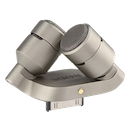Creatively using audio recording in practice
How we use real-time audio recording to enhance practice.

A perpetual search for novelty in practice revealed some cool ways to use real-time audio recording to enhance practice.
Why audio recording is the best feedback during practice
The best instrumental practice is focused and specific. Sure, any time a child is playing her instrument, she’s getting some benefit from it. But focusing kids' efforts in targeted ways is going to yield the most improvement. The best practice is specific, focused, and tailored by practice that is equally specific and focused.
But this sort of deliberate practice is hard, especially for kids.
You can bowl the ball, hear some pins falling, but have no idea how to modify your technique.
Something my daughter said one day during practice had me think about using real-time audio feedback. She was flustered by trying to manage too many difficult things at once and still have any “bandwidth” to actually listen to how she was playing. It makes complete sense; so we started experimenting with audio recording during practice.
I’m happy to say that it has been very successful. Here’s why:
1. Audio recording offloads the task of evaluation from the work of execution
By uncoupling the doing and the evaluation, you can reduce the mental workload of practice.
2. It’s easier to define the audible target that you’re looking for
If I shout out “Great - like that!” during practice, the moment of recognition is fleeting. But if I can record several repetitions, we can go through them repeatedly during play-back and critique them together. Of course, immediate feedback offers the greatest potential for actually modifying technique in the moment, but for honing critical listening skills and discernment, this can be invaluable.
3. Recording parts of practice can be a source of interesting insights.
For example, I asked my daughter to do several repetitions of a passage where we were looking for a terraced crescendo, from p to mf to f. When we looked at the waveforms on the playback, we could spot the best repetition without even listening, because you could easily see the increasing amplitude over the three measures of that practice unit.

You can see that there’s only a little crescendo in the first repetition, but by the fourth repetition, the dynamic increases nicely. And it corresponds exactly to what we heard in the audio. It’s way to engage more senses to understand the musical expressive need in the passage.
4. It’s less distracting than video
Video has its roles, particularly in helping with feedback on posture and presentation. But in music, everything we do is to serve the quality and accuracy of the sound output; so audio recording is the most direct way to access it. And video can be distracting. I find that we’re much more focused on the music when we use audio alone.
How we use audio recording
There are many ways to use audio recording in practice. We’ve made use of several of these:
1. Using audio recording to “harvest” ideas for refinement
Sometimes it’s hard to prioritize aspects of a passage for refinement. We’ve used audio recordings to gather ideas about what needs more focused work. To do this, you can record as much or as little as you want. I tend to record only fairly short logical parts of the piece, so that we can quickly hone in on areas for improvement.
2. Evaluating repetitions
You can press “Record” and start capturing a series of repetitions of a short passage. When we play it back together, we can listen for the aspects she’s trying to improve, give each repetition a “thumbs-up” or “thumbs-down.” Or it can be more open-ended: “What did you like about that repetition? What did you think of your phrasing there?"
3. Documenting progress
Sometimes, with longer more complex pieces, it’s hard for the child to appreciate just how much progress they’re making. A few representative recordings along the way can mark progress in a way that makes it more evident.
How we record practice - equipment, technique
Although we’ve used some specialized equipment to capture audio in the practice room, it’s hardly necessary. Even just an iPhone recording with the Voice Memos app can work.

However, being able to capture higher quality audio has its benefits. Right now, we’re using an iPad with a Rode iXY microphone recording onto the Hokusai 2 app^[There are many similar apps, most of which I haven’t yet evaluated.]. I set everything up on a second music stand so that it doesn’t fight for space with the music books. I use the older version of the iXY mic - one which connects to the iPad via a cord, so I clip it to the stand using a binder clip.
After setting it up, the use is up to you. We’ve found that audio can add a lot to practice. Not only does it breakup the routine, but it helps focus attention on specific areas for audible improvement.





